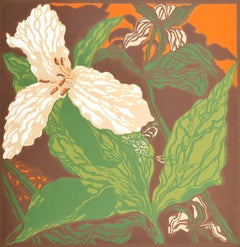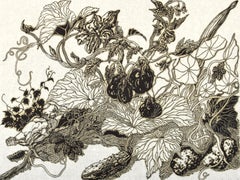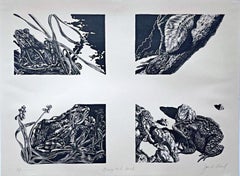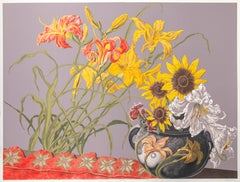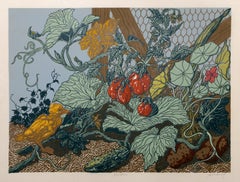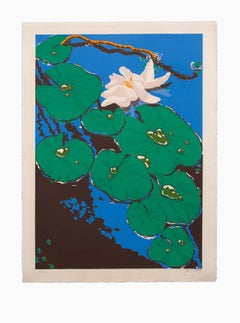Jack Beal Art
American, 1931-2013
Walter Henry "Jack" Beal Jr. was an American realist painterto
1
12
12
8
7
1
Jack Beal TRILLIUM Linocut
By Jack Beal
Located in Lake Worth Beach, FL
Artist/Designer; Manufacturer: Jack Beal (American, 1921-2013)
Marking(s); notes: signed; AP X for the edition of 50
Materials: ...
Marking(s); notes: signed; AP X for the edition of 50
Materials: ...
Category
20th Century Jack Beal Art
Materials
Linocut
Blue Crab, American Realist Screenprint by Jack Beal
By Jack Beal
Located in Long Island City, NY
Artist: Jack Beal, American (1931 - 2013)
Title: Blue Crab
Year: circa 1975
Medium: Screenprint, Signed and numbered in pencil
Edition: 52
Image Size: 9 x 12...
Category
1970s American Realist Jack Beal Art
Materials
Screen
Jack Beal KIDDO Linocut
By Jack Beal
Located in Lake Worth Beach, FL
Artist/Designer; Manufacturer: Jack Beal (American, 1921-2013)
Marking(s); notes: signed; AP 2/6 for the edition of 27; 1977-78
...
Marking(s); notes: signed; AP 2/6 for the edition of 27; 1977-78
...
Category
20th Century Jack Beal Art
Materials
Linocut
Frogs and Toad, Signed lithograph (AP), from Conspiracy: The Artist as Witness
By Jack Beal
Located in New York, NY
Jack Beal
Frogs and Toad, 1971
Hand signed in pencil by Jack Beal, annotated AP
One-color lithograph proofed by hand and pulled by machine from a zinc plate on Arches buff paper with deckled edges at the Shorewood Bank Street Atelier
Stamped, hand numbered AP, aside from the regular edition of 150 Stamped on reverse: COPYRIGHT © 1971 BY JACK BEAL, bears blind stamp
18 × 24 inches
Unframed
18 x 24 inches
Stamped on reverse: COPYRIGHT © 1971 BY JACK BEAL, bears distinctive blind stamp of publisher (shown) Publisher: David Godine, Center for Constitutional Rights, Washington, D.C.
Jack Beal's "Frogs and Toads" is a classic example of protest art from the early 1970s - the most influential era until today. This historic graphic was created for the legendary portfolio "CONSPIRACY: the Artist as Witness", to raise money for the legal defense of the Chicago 8 - a group of anti-Vietnam War activists indicted by President Nixon's Attorney General John Mitchell for conspiring to riot during the 1968 Democratic National Convention. (1968 was also the year Bobby Kennedy was killed and American casualties in Vietnam exceeded 30,000.) The eight demonstrators included Abbie Hoffman, Jerry Rubin, David Dellinger, Tom Hayden, Rennie Davis, John Froines, Lee Weiner, and Bobby Seale. (The eighth activist, Bobby Seale, was severed from the case and sentenced to four years for contempt after being handcuffed, shackled to a chair and gagged.) Although Abbie Hoffman would later joke that these radicals couldn't even agree on lunch, the jury convicted them of conspiracy, with one juror proclaiming the demonstrators "should have been shot down by the police." All of the convictions were ultimately overturned by the 7th Circuit Court of Appeals.
This lithograph has fine provenance: it comes directly from the original Portfolio: "Conspiracy The Artist as Witness" which also featured works by Alexander Calder, Nancy Spero and Leon Golub, Romare Bearden Sol Lewitt, Robert Morris, Claes Oldenburg, Larry Poons, Peter Saul, Raphael Soyer and Frank Stella - as well as this one by Jack Beal. It was originally housed in an elegant cloth case, accompanied by a colophon page. This is the first time since 1971 that this important work has been removed from the original portfolio case for sale. It is becoming increasingly scarce because so many from this edition are in the permanent collections of major museums and institutions worldwide.
Jack Beal wrote a special message about this work on the Portfolio's colophon page. It says, "In 1956, shortly after Sondra and I moved to New York, two friends were arrested and jailed for protesting air-raid drills. From them and their friends came our education. This work is dedicated to them and their families. "In Memory of Patricia McClure Daw and AL Uhrie" - This print was made for their children.
Jack Beal Biography:
Early in his career Walter Henry “Jack” Beal Jr. painted abstract expressionist canvases, because he believed it was “the only valid way to paint.” By the early 1960s he totally altered his approach and fully repudiated abstraction. Turning to representation, he painted narrative and figurative subjects, often enhanced by bright colors and dramatic perspectives.
Beal was born in Richmond, Virginia, and from 1950 to 1953 he attended the Norfolk Division of William and Mary College Polytechnic Institute, (now Old Dominion University) where he studied biology and anatomy. Shifting gears, he sought art training at the School of the Art Institute of Chicago where he focused on drawing, and met his wife, artist Sondra Freckelton. His art history instructor encouraged her students to paint in the manner of established artists, and to that end he frequented the Institute’s galleries. For Beal this was significant: “Until I saw pictures of real quality I had tended to think of painting as just so much self-indulgent smearing around, but when I saw masterpieces by Cézanne and Matisse, and other painters of similar stature, I was bowled over; suddenly I realized the force of art.”
After spending three years (1953–1956) at the Art Institute, Beal concluded his studies there without getting a terminal degree, thinking it was only useful if he wanted to teach, which, at the time, he did not. He also took courses at the University of Chicago in 1955 and 1956. During this period he married Freckelton, a fellow student and sculptor who began her career working in wood and plastic. Together they moved to New York’s SoHo District before its transformation from a wasteland of sweatshops and small factories into an arts district. They were active with the Artist Tenants Association which was instrumental in getting zoning laws changed so that artists could live and work in the well-lit lofts.
Embracing what came to be called “New Realism,” Beal initially painted an occasional landscape as well as earthy-toned still lifes which consisted of jumbled collections filled with personal objects. His signature style started with a series of female nudes—all modeled by Freckelton—based on Greek mythology. These were large canvases with flat paint surfaces, dramatic foreshortening, and unusual perspectives. He further enlivened them with vivid colors, stark lighting, and dynamic patterns derived from textiles and overstuffed furniture. He stopped painting nudes after two episodes. The first came as he was loading a canvas of his naked wife onto a truck in lower Manhattan; several laborers walked by and started to fondle and kiss the painting. On the one hand he felt his wife had been violated, while on the other he was pleased that his realism was so convincing. The second occurred after a solo exhibition in Chicago at which the reception had been sponsored by Playboy magazine. A few days later he was approached by a publicist and asked if Playboy bunnies could be photographed in front of his paintings. He refused.
Some portrait commissions came Beal’s way, but he preferred only portraying friends. More significant were four large murals on the History of Labor in America, the 20th Century: Technology (1975), which he undertook for the headquarters of the United States Department of Labor in Washington. Following a historical timeline, the themes were: colonization, settlement, nineteenth century industry, and twentieth century technology. The unveiling ceremony was attended by government officials and Joan Mondale, an arts advocate and wife of the vice-president. The reviewer for the Washington Post wrote enthusiastically: “They’re heartfelt and they’re big (each is 12 feet square). Their many costumed actors (the Indian, the trapper, the scientist, the hardhat, the capitalist in striped pants, the union maid, etc.) strike dramatic poses in dramatic settings (a seaside wood at dawn, an outdoor blacksmith’s forge, a 19th-century mill, a 20th-century lab). The lighting is theatrical. Beal’s compositions, with their swooping curves and bunched diagonals, are as complicated as his interwoven plots.” To accomplish the murals Beal assembled a team of assistants and models, much in the manner of Renaissance masters, which included artist friends and Freckelton. who by then was painting brightly colorful still lifes.
A second mural commission ensued from New York City’s Metropolitan Transit Authority for two twenty-foot long installations for the Times Square Interborough Rapid Transit Company subway station. Beal’s designs for The Return of Spring (installed in 2001, three days after the terrorist attacks in New York, Washington, DC and Philadelphia) and The Onset of Winter (installed in 2005), Beal captured the appearance of his models in an oil painting made to the scale of the intended mosaic. A collaboration with Miotto Mosaics, the canvases were shipped to the Travisanutto Workshop, in Spilimbergo, Italy, where craftsmen fabricated the design to glass mosaics. The Return of Spring depicted construction workers and other New Yorkers in front of a subway kiosk and an outdoor produce market and in The Onset of Winter, a crowd watches a film crew recording a woman entering the subway as snow falls against the city’s skyline. Harkening back to some of his early nudes based on Greek myth, Persephone, goddess of fertility and wife of Hades, appears in both. The symbolism is pertinent, since she spent six months each year below ground.
Although he disparaged teaching early on, Beal and Freckelton offered four summertime workshops on their farm in Oneonta, New York. He was an instructor at the New York Academy of Art, a graduate art school he helped to establish in 1982. Returning to Virginia, he taught at Hollins College...
Category
1970s Realist Jack Beal Art
Materials
Lithograph
Buds, Still Life Realist Screenprint by Jack Beal
By Jack Beal
Located in Long Island City, NY
Artist: Jack Beal, American (1931 - 2013)
Title: Buds
Year: circa 1975
Medium: Screenprint, signed and numbered in pencil
Edition: 50
Size: 31 in. x 41 in. (78.74 cm x 104.14 cm)
Category
1970s American Realist Jack Beal Art
Materials
Screen
Garden, Pop Art Screenprint by Jack Beal
By Jack Beal
Located in Long Island City, NY
Artist: Jack Beal, American (1931 - 2013)
Title: Garden
Year: circa 1975
Medium: Screenprint, Signed and numbered in pencil
Edition: 74
Image: 18 x 24 inches
Sheet Size: 24.5 in. x 3...
Category
1970s Realist Jack Beal Art
Materials
Screen
$960 Sale Price
20% Off
Buds
By Jack Beal
Located in Fairlawn, OH
Buds
Color lithograph, 1980
Signed, titled, and editioned in pencil by the artist
Publisher: Art Matters
Printer: Bud Shark, Shark's Ink, Lyons, CO
Condition: Excellent
Image: 31-1/8 x 41-1/4" (79 x 104.7 cm.)
"An Abstract Expressionist when he left the Art Institute of Chicago in 1956, Beal has since become a dedicated realist who sees art as a potentially powerful moral force. He has great regard for Platonic ideals of truth, beauty, and goodness, and admires both the realism of seventeenth-century Dutch painting and the compositional authority of Renaissance art. Since moving to New York in the late 1950s with his wife, painter Sondra Freckelton, Beal has painted still lifes, portraits, and landscapes, although in recent years his most ambitious undertakings have been large-scale allegories and myths. In describing his approach, Beal calls himself a "life painter" and says he is committed to human over aesthetic concerns. Yet his intricate complexes of figures and surface patterns, along with his adroit handling of space, reveal his sophisticated, accomplished sense of composition.
Virginia M. Mecklenburg
Biography
Jack Beal (1931-2013) was born and raised in Richmond, Virginia. He briefly attended the College of William and Mary, studying biology, but dropped out after two years. A decision to take evening art classes lead to his attending the Art Institute of Chicago, where he studied from the old masters in the Institute’s collection and with Isobel Steele MacKinnon, a student of Hans Hoffman. His classmates there included Red Grooms, Richard Estes, Claes Oldenberg and Robert Barnes, and while abstract expressionism remained “the only valid way to paint,” it was a style that all would eventually reject. In 1956 Beal left the Art Institute and moved to New York with the aim of finding success as a painter, eventually becoming one of the first artists to settle in the SoHo neighborhood.
A turning point came in 1962 when, spending the summer in upstate New York, Beal decided to begin painting outdoors. Dissatisfied with abstract painting, he “wanted to give Art one more try” and in working from nature “fell in love with painting all over again.” Over the next few years Beal worked toward a balance between expressionistic paint handling and realistic, narrative pictures. Clement Greenberg’s pronouncement around this time, that the figure was no longer a valid subject was taken as a challenge by many artists, Beal included. His subsequent adoption of the female nude - modeled by his wife, the artist Sondra Freckelton - was a break-through. Though the paintings retained the sensuousness of his earlier canvases, the rigorous formality of their composition and the masterful treatment of light and shadow offered a new approach to realist painting. Indeed, Beal was not alone in this transformation; friends and colleagues in New York were coming to similar conclusions and the group, who included painters such as Philip Pearlstein, Alfred Leslie, Yvonne Jacquette, Alex Katz, Jack Tworkov, Nell Blaine and Fairfield Porter, would eventually be considered the ‘New Realists.’
With the resurgence of figurative painting, Beal distinguished himself for his skillful handling of color and modeling as well as what was later described as his “pushing of representational forms to their interface with abstraction”. Through the later half of the 1960s, while his subject matter remained unchanged, his paintings were increasingly given over to wide areas of flat color. In 1969, he exhibited a series of Table Paintings which, with their hard-edge style and near complete abstraction of the form, were a radical departure for Beal. So radical in fact, he was accosted by fellow realist painters Alfred Leslie and Sidney Tillim, who berated him “for betraying realism and betraying [himself], for moving away from ‘the true path’.” The incident had its intended effect and Beal did return to a more naturalistic and humanistic style, eventually abandoning the nude in favor of increasingly allegorical portraits. In 1974, the United States General Services Administration commissioned Beal to produce a series of murals for the U.S. Department of Labor headquarters in Washington D.C. The result was The History of Labor, four, 12 x 13 foot paintings in the vein of George Caleb Bingham, each illustrating a century of American development.
Following the completion of the murals in 1977, Beal continued to make use of narrative in his paintings, with portraiture and self-portraiture as a means of exploring moral and didactic themes. He and Sondra had purchased an old mill in upstate New York in 1974 and after extensive renovations, it became their permanent residence. Unsurprisingly, many of his later paintings are pastoral scenes based on his rural surroundings or still lives including flowers which they grew on the property. In 1986, Beal was commissioned by the Art in Transit Initiative to create a large-scale mural as part of the redevelopment of the Times Square Subway Station. The proposed mosaic mural, The Return of Spring, took over fifteen years to complete, with the two, 7 x 20 foot sections finally installed in 2001 and 2005. Together they update the Greek myth of Persephone with a New York setting, showing her abduction by Hades, initiating the arrival of winter, and her release, bringing the bountiful return of spring.
Beal was a founder of the Artist’s Choice Museum, New York and the New York Academy of Art as well as the recipient of numerous grants and awards, including honorary degrees from the Art Institute of Boston and the Hollins College...
Category
1980s Contemporary Jack Beal Art
Materials
Lithograph
$1,200
Wisconsin, American Realist Black and White Lithograph by Jack Beal
By Jack Beal
Located in Long Island City, NY
Artist: Jack Beal, American (1931 - 2013)
Title: Wisconsin
Year: circa 1975
Medium: Lithograph, signed and numbered in pencil
Edition: 50, AP 6
Size: 22 in. x 27.5 in. (55.88 cm x 69...
Category
1970s American Realist Jack Beal Art
Materials
Lithograph
Frogs and Toads, Realist Black and White Lithograph by Jack Beal
By Jack Beal
Located in Long Island City, NY
Artist: Jack Beal, American (1931 - 2013)
Title: Frogs and Toads - Conspiracy: The Artist as Witness
Year: 1971
Medium: Lithograph, signed and numbered i...
Category
1970s Realist Jack Beal Art
Materials
Lithograph
Jack Beal STILL LIFE II Lithograph
By Jack Beal
Located in Lake Worth Beach, FL
Artist/Designer; Manufacturer: Jack Beal (American, 1921-2013)
Marking(s); notes: signed, blind stamp; Trial; 1978
Materials:
Marking(s); notes: signed, blind stamp; Trial; 1978
Materials:
Category
20th Century Jack Beal Art
Materials
Lithograph
Jack Beal CONSPIRACY Portfolio Screenprint
By Jack Beal
Located in Lake Worth Beach, FL
Artist/Designer; Manufacturer: Jack Beal (American, 1931-2013)
Marking(s); notes: signed, blind stamp, marking(s); ed. 69/150; 1971
Materials: lithograph on Arches buff
Dimensions (H...
Category
1970s Contemporary Jack Beal Art
Materials
Lithograph
Jack Beal WOMAN WITH FAN Linocut
By Jack Beal
Located in Lake Worth Beach, FL
Artist/Designer; Manufacturer: Jack Beal (American, 1921-2013)
Marking(s); notes: signed; AP 1/6
Materials: linoleum cu...
Marking(s); notes: signed; AP 1/6
Materials: linoleum cu...
Category
20th Century Jack Beal Art
Materials
Linocut
Related Items
Pintail
Located in San Francisco, CA
This artwork titled "Pintail" c.1990 is a color lithograph by noted Wild life American artist Christopher Forrest, b.1946. It is hand signed, titled and numbered 86/300 in pencil by the artist. The image size is 17.5 x 22.85 inches, framed size is 27.35 x 32.5 inches. Custom framed in a oak frame, with light brown matting. It is in excellent condition
About the artist:
Born in Trenton, New Jersey, 1946 Interested in art from the age of 7, Christopher Forrest still speaks fondly of a set of colored pencils presented to him then by his parents; At 11, he won his first award for painting and started exhibiting in galleries. Along with his interest in art grew a keen attraction for the outdoors and the wildlife which thrived there. After considering schooling in art, Chris chose to study civil engineering. Upon graduation from Virginia Polytechnic Institute, Chris began a career as a commissioned officer in the United States Army Corps of Engineers. The Army provided Chris the opportunity to observe wildlife from the swamps of Florida to the lakes of Quebec, in addition to Europe and Viet Nam. In 1973, the Army sent Chris to graduate school at North Carolina State University, at this time Chris started to paint wildlife. Chris resigned from the Army in 1978 and took a position as an artist with Evergreen Publishing Co. He has produced more than thirty original graphic editions for Evergreen. His original graphics are handled by some 350 galleries in North America. He is currently General Manager at Evergreen. His work and articles about his work have appeared in numerous wildlife and art publications. Chris strongly believes in wildlife conservation and is a member of many conservationist organizations. His donated prints have raised a great deal of money for Ducks Unlimited, Newjersey, Audubon and Ward Foundations. In 1980 he realized one of his major professional goals. He was elected to membership in the Society of Animal Artists. "Creating a painting or graphic is an exciting adventure and challenge for me. Starting with the observation of the animal in the wilderness, I then approach the painting with the attitude that it will be my finest work." COLLECTIONS National Academy of Science, Washington, D.C. New Jersey State Museum, Trenton, N.J. Ferrum College, Ferrum, Va. Franklin Mint, Franklin Center, Pa. Parsons, Brinkerhoff, Quade & Douglas, consulting Engineers, N.Y.C. Fine Art Corporation of America, N.Y.C. Central Carolina Bank, Raleigh, N.C. Ward Foundation Museum, Salisbury, Md. New Jersey Audubon Society, Rancocas, N.J. I.B.M., Louisville, Ky. American World Airways (Pan Am), Miami, Fla. Baush & Lomb, Rochester, N.Y. Thermos, Norwich, Conn. Metro-Goldwyn Mayer, Ca. Ford Motor Co., Atlanta, Ga. Chemical Bank, N.Y.C. City Bank, N.Y.C. ONE-MAN SHOWS N.J. State Museum, Trenton, N.J. 1979 Palette Gallery, Cary, N.C., 1973,-74,-77,-78,-79 Lambertville House, Lambertvi lie, N.J., 1975-76 Triangle Art, Trenton, N.J., 1975 INVITATIONAL SHOWS Triangle Art Christmas Show, 1975 Golden Door Gallery Wildlife Show, New Hope, Pa., 1976 Ward Foundation Wildlife Art & Carving Exhibition, Salisbury and Ocean City, Md., 1976,-78,-79 Easton Waterfowl Art...
Category
Late 20th Century American Realist Jack Beal Art
Materials
Lithograph
Iris
By Gary Bukovnik
Located in San Francisco, CA
This artwork titled "Iris" 1998 is an original color lithograph on Wove paper by noted American artist Gary Bukovnik, born 1947. It is hand signed, dated and numbered 109/200 in pencil by the artist. The image size is 10 x 9.75 inches, sheet size is 14.75 x 13.5 inches. It is in excellent condition, the colors are fresh and bright, has never been framed.
About the artist.
Born and educated in Cleveland Gary Bukovnik has lived in San Francisco for over 25 years. Primarily using the mediums of watercolor, monotype, and lithograph, Bukovnik creating colorful floral images of great depth and intensity.
Bukovnik collaborates with Trillium Press, whose owner and master printer, David Salgado, studied at the Tamarind Workshop, formerly in Los Angeles.
In 2003, the American Academy in Rome invited Bukovnik to attend the academy as a Visiting Artist for six weeks. He was asked to attend a second session in February 2005. In 2001, he was selected to create a poster for the prestigious List Collection, which creates posters to commemorate programs at Lincoln Center for the Performing Arts in New York. Lincoln Center past contributors have included Roy Lichtenstein, Andy Warhol, Robert Motherwell, Helen Frankenthaler, Alex Katz, Elizabeth Murray, and Donald Sultan. The work of Gary Bukovnik is held in public and private collections worldwide.
Selected Museums
Art Gallery of Hamilton, Ontario The Art Institute of Chicago Atlanta Botanical Garden Brooklyn Museum
Brooks Museum of Art, Memphis
The Butler Institute of American Art, Youngstown Dallas Museum of Art
Fine Arts Museums of San Francisco
Frye Art Museum, Seattle
Hunt Institute for Botanical Documentation, Carnegie Mellon University, Pittsburgh
Hunterian Art Gallery, University of Glasgow
Library of Congress, Washington, DC
The Metropolitan Museum of Art, New York
The Minneapolis Institute of Arts, Minnesota Museum of Fine Arts, Boston
The Museum of Modern Art, New York
The Richard L. Nelson Gallery, U.C. Davis, California The New York Public Library
Oakland Museum of California
Philadelphia Museum of Art
Phoenix Art Museum
Portland Art Museum, Oregon
Rhode Island School of Design Museum, Providence San Francisco Museum of Modern Art
University of Arizona Museum of Art, Tucson University of California, Berkeley Art Museum
Selected public collections
ALZA Corporation, Mountain View
ART In Embassies Program, U.S. Department of State
AT&T, New York
Atlantic Richfield, Los Angeles
BankAmerica Corporation, Charlotte
Citigroup, New York
Cleveland Institute of Music
Clorox Company, Oakland
Comerica Bank, Costa Mesa & San Jose
H.J. Heinz Company, Pittsburgh
Illinois Bell Telephone...
Category
Mid-20th Century American Realist Jack Beal Art
Materials
Lithograph
Original Italian Emidio di Nola Italian Macaroni original vintage food poster
Located in Spokane, WA
Emidio di Nola, original Italian pasta poster. Size 19" x 25.5". Professional acid-free archival linen-backed; in excellent condition; ready to frame....
Category
1950s Aesthetic Movement Jack Beal Art
Materials
Lithograph
$750
H 25.5 in W 19 in D 0.05 in
"A Dance in Otaheite" (Tahiti), Engraving from Captain Cook's 3rd Voyage
By John Webber
Located in Alamo, CA
"A Dance in Otaheite" (Tahiti) is an engraving created by William Sharp (1749-1824), from a drawing by John Webber (1752-1793), who was the artist on Captain James Cook's 3rd and final voyage of discovery. It is a plate in the atlas of "A Voyage to the Pacific Ocean Undertaken by the Command of His Majesty, for Making Discoveries in the Northern Hemisphere", the official British Admirality sanctioned journal published upon completion of the voyage in London in 1784 by Strahan & Cadell.
Two women and two men wearing ceremonial costumes, performing a dance outdoors standing on a mat. Three men are playing the drums in the background, in front of a thatched roof building. An audience of men are sitting on both sides of the stage. By the time Webber arrived in Tahiti, 'south sea' imagery had become familiar. Webber gave concentrated attention to dance. He had the opportunity to distinguish the Tahitian dance from the more formalized dancing of Tonga. Whereas they seem to have called to mind the more formal dances of antiquity, the Tahitian dancing aroused memories of peasant and folk dancing.
This engraving is professionally framed in Koa wood. Koa wood is legendary in Hawaii. Not only is this amazing wood native to Hawaii, but it is known for the deep rich colors and varied grain pattern. Koa has an honored heritage in Hawaii and is highly revered and sacred. The word “koa” means “warrior” in Hawaiian. The warriors of King Kamehameha the Great, created canoes and weapons from a wood plentiful on the Big Island of Hawaii. This wood became synonymous with the warriors themselves, and it became known as koa.
The print is in excellent condition.
There are three other engravings listed from the official journal of Captain Cook's 3rd voyage available that are presented in identical Koa wood frames and double mats (LU117324682432, LU117324684052, LU117324684062). They would make a wonderful grouping for a display of 2, 3 or 4 prints. A discount is available for a grouping depending on the number of items included.
Hawaii was discovered by Captain Cook during this voyage. Hawaii was originally called The Sandwich Islands in honor of The Earl of Sandwich...
Category
1780s Realist Jack Beal Art
Materials
Engraving
$1,900 Sale Price
20% Off
H 21.75 in W 23.75 in D 0.88 in
Mediterranean Seascape, Nautical Cyanotype on Watercolor Paper, Blueprint
By Kind of Cyan
Located in Barcelona, ES
This is an exclusive handprinted limited edition cyanotype.
"Mediterranean Blue Sea Waves" is a handmade cyanotype print of the subtle tidal flow moving in on the Mediterranean Sea.
...
Category
2010s Realist Jack Beal Art
Materials
Emulsion, Watercolor, Rag Paper, Lithograph
19th century color lithograph butterflies flowers nature trees scene signed
By Louis Prang
Located in Milwaukee, WI
"Erycinids" is an original color lithograph by Louis Prang. It depicts colorful butterflies around a variety of flowers.
5" x 8" art
16 1/2" x 19" framed
Louis Prang was an American printer, lithographer, and publisher. He is sometimes known as the father of the American Christmas card. He created L. Prang and Company in 1860 and became successful and known for their Civil War maps...
Category
Late 19th Century American Realist Jack Beal Art
Materials
Lithograph
$1,815
H 16.5 in W 19 in
Tulips in a Vase
By Gary Bukovnik
Located in San Francisco, CA
This artwork "Tulips in a Vase" 1995 is an original color lithograph on Wove paper by noted American artist Gary Bukovnik, born 1947. It is hand signed, dated and numbered 169/200 in...
Category
Mid-20th Century American Realist Jack Beal Art
Materials
Lithograph
Original 1944 "... because somebody talked!" vintage poster
Located in Spokane, WA
Original vintage poster: …BECAUSE SOMEBODY TALKED. Original World War II (2) linen-backed 1944 poster.
Artist: Wesley Heyman. Size 20" x 28" Linen backed. Excellent condition. Antique poster ready to frame. Original issued U. S. Government fold marks touched up during linen backing. This is not considered a defect on World War II posters.
Because Someone Talked portrays a cocker resting his head on his master's scarf. The gold star flag behind his head reveals that his master has been killed in action. The flag was awarded to mothers who lost sons.
Published by the United States Government Printing Office
Interpretation This poster, issued by the United States government during World War II, is a warning to citizens that discussing troop movements, or other military information that might be useful to the enemy, could have serious consequences. The Service Flag...
Category
1940s American Realist Jack Beal Art
Materials
Offset
$775
H 28 in W 20 in D 0.05 in
Springtime in the North
Located in San Francisco, CA
This artwork titled "Springtime in the North" c.1980, published 1996, is a color offset lithograph by renown western artist Arnold Friberg, 1913-2010. I...
Category
Late 20th Century American Realist Jack Beal Art
Materials
Lithograph
'Sister, A portrait of the Moon' , Signed Etching c2021
Located in Frome, Somerset
'Sister' , by contemporary printmaker and artist Rosie McLay (British)
Edition 59 of 75 in total, handmade etching by the artist.
Ink on paper layed on Dutch gold leaf.
Hand etched ...
Category
2010s Realist Jack Beal Art
Materials
Engraving
$619
H 17.72 in W 17.72 in D 1.19 in
Georgia O'Keeffe, Limited Edition Flower Poster with beautiful Friendship Quote
By Georgia O'Keeffe
Located in New York, NY
Georgia O'Keeffe, Red Poppy poster, with Friendship Quote, 1987
"Still - in a way - nobody sees a flower - it is so small - we haven't time- and to see takes time, like to have a fr...
Category
1980s American Realist Jack Beal Art
Materials
Lithograph, Offset
$690
H 24 in W 19.5 in
Vintage David Hockney Poster Miami New World Festival of Arts 1982 palm trees
By David Hockney
Located in New York, NY
This vintage David Hockney poster features whimsical imagery and rich, bright color. Palm trees, boats in the ocean, a cafe, and a bodega with an elaborate iron-wrought balcony sit a...
Category
1980s Realist Jack Beal Art
Materials
Lithograph
Previously Available Items
"Pond Lilies", Color Lithograph Pencil Signed and Numbered (42/120)
By Jack Beal
Located in Detroit, MI
"Pond Lilies" by Jack Beal is a 1971 work from the "Ten Lithographs by Ten Artists" portfolio that was put together and published for the Skowhegan School of Painting and Sculpture i...
Category
1970s Jack Beal Art
Materials
Lithograph
Garden, Silkscreen by Jack Beal
By Jack Beal
Located in Long Island City, NY
Artist: Jack Beal, American (1931 - 2013)
Title: Garden
Year: circa 1975
Medium: Silkscreen, Signed and numbered in pencil
Edition: 74
Size: 24.5 in. x 30 in. (62.23 cm x 76.2 cm)
Category
1970s Realist Jack Beal Art
Materials
Screen
Doyle's Glove
By Jack Beal
Located in Long Island City, NY
Artist: Jack Beal, American (1931-2013)
Title: Doyle's Glove
Year: 1969
Medium: Screenprint on Rives BFK, signed and numbered in pencil
Edition: 50/60
Image Size: 12 x 13 inches
Size...
Category
1960s Pop Art Jack Beal Art
Materials
Screen
Jack Beal art for sale on 1stDibs.
Find a wide variety of authentic Jack Beal art available for sale on 1stDibs. You can also browse by medium to find art by Jack Beal in screen print, lithograph and more. Much of the original work by this artist or collective was created during the 1970s and is mostly associated with the Photorealist style. Not every interior allows for large Jack Beal art, so small editions measuring 20 inches across are available. Customers who are interested in this artist might also find the work of Theo Wujcik, William Acheff, and Popo and Ruby Lee. Jack Beal art prices can differ depending upon medium, time period and other attributes. On 1stDibs, the price for these items starts at $600 and tops out at $1,200, while the average work can sell for $900.
